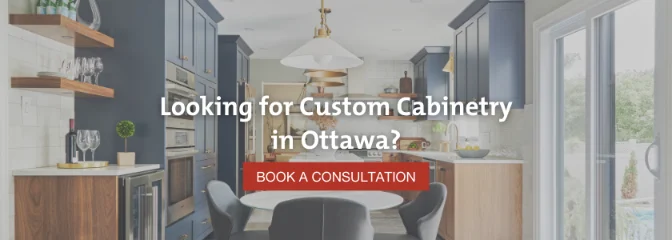6/03/2023 • Blog, Design Tips, Problems
6 Common Kitchen Island Design Mistakes to Avoid
Estimated Read Time: 6 Minutes
Kitchen islands have seen a continuous rise in popularity in recent decades. In some respects, it’s become almost customary to include a central island in contemporary kitchens.
With such a vital role in the kitchen, designing the perfect island can be an arduous task.
At Deslaurier, we have over 40 years of experience manufacturing custom cabinets and providing kitchen design services. In that time, we’ve designed thousands of kitchens and know that the best way to ensure a successful design is by knowing what mistakes to avoid.
Join us as Deslaurier design consultant Adele Jacobs shares her years of experience and highlights 6 crucial kitchen island mistakes you should avoid at all costs!
|
Table of Contents |
|
The Island is Too Big or Too Small |
1. The Island is Too Big or Too Small for the Kitchen
The size of the island should be proportional to the size of the kitchen. Unfortunately, that’s not always how things end up.
If the island is too large, it can impede movement and make the kitchen feel cramped. Conversely, if the island is too small, it may not be functional enough.
“A lot of times clearance or travel pathways are sacrificed for the size of the island” - Deslaurier designer, Adele Jacobs
In this case the island becomes a problem rather than the solution they were looking for.
Having an island that’s too small can cause major problems as well. A lot of people use the island as a work surface for food preparation and cleaning up, or as a place to eat meals and host guests.
The last thing you want is an island that’s too small to properly do either, let alone both.
The best solution? Measure. Measure. Measure.
Ensure your island fits perfectly within your kitchen and download our Kitchen Measurement Guide below!
2. It Doesn’t Have a Clear Purpose
During the design phase, you’ll have to ask yourself, “what is the island’s purpose?”
Some homeowners will include an island just for the sake of having one—that’s not the best idea. Your island will effectively become a piece of furniture – or worse, an obstacle – in the middle of your kitchen.
“You need to determine how you’ll use [the island] in the context of your kitchen” - Jacobs
An island without an established purpose will just take up valuable kitchen space.
If your vision for the island is primarily as a workstation, you may find that you wish it had seating. Conversely, if you focus too much on providing seating for entertaining, you may discover in retrospect that there is not enough workspace to meet your needs.
Most people want their island to fall somewhere in the middle of a kitchen workstation and social hub. Knowing this in advance will allow you to allocate enough space to satisfy both functions.
Identify your island’s purpose early on in the design phase and you’ll reap the benefits for years to come.
3. Not Enough Seating Space
Planning kitchen island seating is a far more significant task than it sounds. It’s more than just throwing a few stools underneath the countertop overhang.
You’ll need to put a lot of thought into the type of seating, and how many seats you want.
When deciding how many seats you want, ensure you give each person at least 24" of space per seat. The last thing you want is people bumping elbows during meals!
For example, if your island is six feet long, that’s enough room to comfortably seat three. If it’s eight feet–4 seats, and so on. If that’s not enough for your large family or social lifestyle, you can always continue overhang seating onto a second side of your island!
.jpg?width=800&height=533&name=Deslaurier_Trailway-1%20(1).jpg)
Further, successful island seating isn’t just about the space between each seat, but also the distance from the seats to the back of the island.
“If you’re going to eat breakfast at the island and plan on using it often, you’ll want at least 12 to 15 inches of countertop overhang” - Jacobs
If you really want to be able to tuck in your stools underneath the overhang, or are worried about the hazard of island chairs sticking out into the kitchen area, having a countertop overhang depth closer to 18 inches would be ideal.
4. There’s Not Enough Clearance
As we mentioned, having a proportionately sized island is vital in the way the rest of your kitchen space functions. Another important consideration is how much clearance space you have.
The minimum clearance space you’ll need between your island cabinets and perimeter cabinets is 36 to 48 inches.
“I’d say 42 inches of clearance is the ideal” - Jacobs
That gives you enough room to accommodate opening and closing the fridge and loading and unloading the dishwasher. At the 48” mark, you’ll generally have enough room for someone to pass by while an appliance door is open.
Of course, that is a lot of clearance room – 4 feets worth – that not every kitchen layout can accommodate.
Smaller kitchens won’t be able to sacrifice 4 feet of space for island clearance. They’ll lean closer to the minimum of 36 inches, but anything less than that will begin to restrict the function of your kitchen.
Especially if multiple people are working in the kitchen at once, with appliances and cabinets opening and closing, having minimal clearance around your island can make life in the kitchen quite uncomfortable.
5. Plan Electrical Outlets
Most homeowners designing a kitchen island are so preoccupied with their cabinet selection or finding the perfect countertop stone that they overlook a small but crucial issue: electrical outlets!
The electrical building code requires a kitchen island to include at least one power outlet.
While power outlets are a requirement for a kitchen island, they’re also an extremely practical element to have in our modern-day lives.
“A lot of people charge their phones or their tablets on the kitchen island. Many newer outlets can include USB chargers as well” - Jacobs
Knowing that you need an outlet is the straightforward part. Knowing the best location for the outlet to go? Easier said than done. Moving electrical work after the fact can be very messy – and expensive – so you want to get the location of your outlets right the first time.
For starters, you don’t want your outlet to be built into a cabinet with drawers or you’ll have to modify that cabinet as well.
The ideal location of the outlet should be in a cabinet with extra space inside. Typically the most common location is in an island side panel.
Side panels are attached to the side and back of the island cabinets to provide a finished appearance on all ends of the island. They also make for a great place to install an island power outlet without altering any cabinet boxes.
But what if you have plans for your island countertop to continue into luscious waterfall ends, or you simply don’t want an outlet built into side panels?
You can also install an outlet in a front façade or column. This method is best utilized with 4 inches of width, otherwise, you’re cutting into cabinet materials or running the risk of causing structural alterations.
6. Not Including Useful Cabinetry
As we’ve mentioned, the purpose of your island plays a large part in the overall design of your kitchen.
If your island functions as the kitchen’s primary workstation for things like meal prep or cleanup, there are a few things you might want to include during the design process.
Incorporating waste pullouts and built-in appliances like a dishwasher are a must. They make cleanup a breeze and help contain any meal prep mess in one workstation.
If you plan on using your island for meals, it’s convenient to include cutlery dividers in the island rather than the perimeter cabinets. You’ll have quick and easy access anytime you sit down for a meal!
Design with Deslaurier Custom Cabinets
If you’re including an island in your kitchen design we hope this article helps you avoid common mistakes in your upcoming design project. When it comes to kitchen island design, it’s crucial to make sure you take everything into consideration before completing the design process.
Whether you’re planning a new build or kitchen renovation, Deslaurier Custom Cabinets has everything you need to create the perfect custom island design! With over 40 years of experience in our name, we provide our clients with a fully customized design process with our talented team of designers.
Book a free consultation today with a Deslaurier design expert at our Ottawa Showroom or schedule a virtual meeting online!
Interested in becoming an authorized Deslaurier dealer? Visit our Become a Dealer page to learn more! Live outside the area? Find a Dealer to connect with a Deslaurier dealer near you!
.png?width=224&height=80&name=Final%20(3).png)



